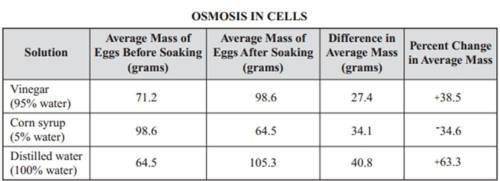
A classic example of osmosis in the classroom involves placing an egg in water or syrup. The egg first sits in vinegar until the shell is dissolved. Then, it is placed in a glass of either tap water or syrup. The mass of the egg is measured. The results are in the chart below. Use what you know about osmosis to explain why the egg increased in mass in the distilled water but decreased in mass in the corn syrup.


Answers: 3
Other questions on the subject: Biology

Biology, 22.06.2019 00:10, rameseshajj
Which would happen if more forests were cut down? a. the nitrogen cycle would be stopped b. nitrogen would be fixed by bacteria more quickly c. the amount of co2 in the atmosphere would increase d. fossil fuels would build up in the soil c the amount of co2 in the atmosphere would increase
Answers: 1

Biology, 22.06.2019 00:30, nayellisoto15
Compare and contrast cladistics and phylogeny. what are their advantages and disadvantages? which is the most useful in understanding how an organism developed into its current form? which concept most strongly supports your opinion about the origin of any given organism?
Answers: 1


Do you know the correct answer?
A classic example of osmosis in the classroom involves placing an egg in water or syrup. The egg fir...
Questions in other subjects:


Mathematics, 18.10.2020 14:01






Chemistry, 18.10.2020 14:01








